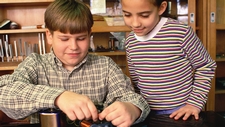Experimental Design

TEKS Objective
The student is expected to plan and implement descriptive investigations, including asking and answering questions, making inferences, and selecting and using equipment or technology needed, to solve a specific problem in the natural world.
Essential Understanding
The student uses scientific inquiry methods during laboratory and outdoor investigations.
Science Background
The Scientific Method: Vision Learning (website) - This is a library of learning modules that provide interactive animations, glossary definitions, current news and research written by professional educators and scientists.
The Scientific Method
Vision Learning, www.visionlearning.com
Research Methods - Experimentation: Vision Learning (website) – This article explains the development of the scientific method throughout time exampled by a few famous experiments.
Research Methods - Experimentation
Vision Learning, www.visionlearning.com
What is Inquiry Science Teaching? BioEd Online (video) – Nancy Moreno, PhD, explains how to use questions and investigations to guide your students' science learning.
What is Inquiry Science Teaching?
BioEd Online, www.bioedonline.org
Signature Lesson
Ball Bouncing Experiment: How To Smile (website) – Different types of balls are tested to see which one bounces the highest and for the longest period. Click the green “Go to Activity” link to obtain the lesson plan.
- Supporting Lessons
- Extensions
- Assessment Ideas
- Literature Connections
- Related
TEKS - Additional Resources
Supporting Lessons
Rippin’ Rockets: How to Smile (website) – In this activity, students observe several different variations of an inflated balloon’s flight. Using this information, they then design a balloon to control the direction and pattern of its flight. Click the green “Go to Activity” link to obtain the lesson plan.
Elaboration Lessons and Extensions
Soda Brand vs. Height Experiment: How To Smile (website) – Using Mentos candy, students test to see if different brands of soda change the erupting gases that result from dropping the candy into the soda bottle. Click the green “Go to Activity” link to obtain the lesson plan.
Soda Brand vs. Height Experiment
How To Smile, www.howtosmile.org
Assessment Ideas
Rubric for Experimental Design: Beacon Learning Center (PDF) – Students can use this rubric to self-assess their projects/ experiments or the teacher can use it summatively.
Rubric for Experimental Design
Beacon Learning Center, www.beaconlearningcenter.com
Literature Connections
How to Build a Better Mousetrap Car and Other Experimental Science Fun. Renner, A., (ISBN-13: 978-0396074199)
What’s the Plan? Designing Your Experiment. Hyde, Natalie. (ISBN-13: 978-0778751540)
Solving Science Questions: A Book About the Scientific Process. Chappell, Rachel M. (ISBN-13: 978-1600445422)
Prize-Winning Science Fair Projects for Curious Kids. Rhatigan, J. (ISBN-13: 978-1579907501)
Additional Resources
Paper Airplanes: Joseph Palmer's Paper Airplanes (website) - This website contains four paper plane models that require no cutting, no weights, and are made from a single sheet of ordinary copier paper.
Paper Airplanes
Joseph Palmer's Paper Airplanes, www.josephpalmer.com
Science Fair Central: Discovery Education (website) – Need help getting started with an independent science experiment? This site provides an abundance of ideas and suggestions.
Science Fair Central
Discovery Education, school.discoveryeducation.com
TEKS Navigation
Grade 3
Need Assistance?
If you need help or have a question please use the links below to help resolve your problem.

Comments